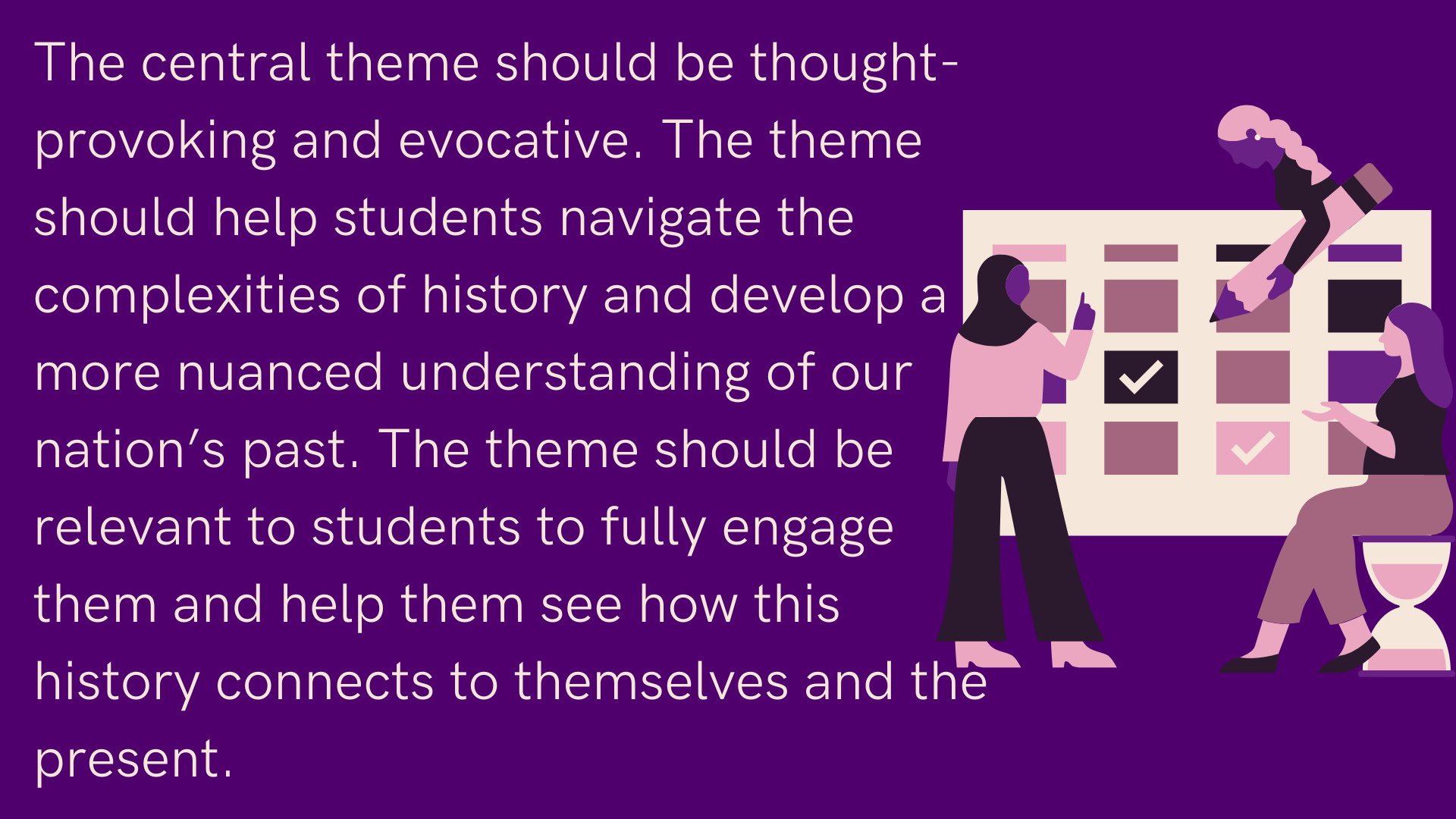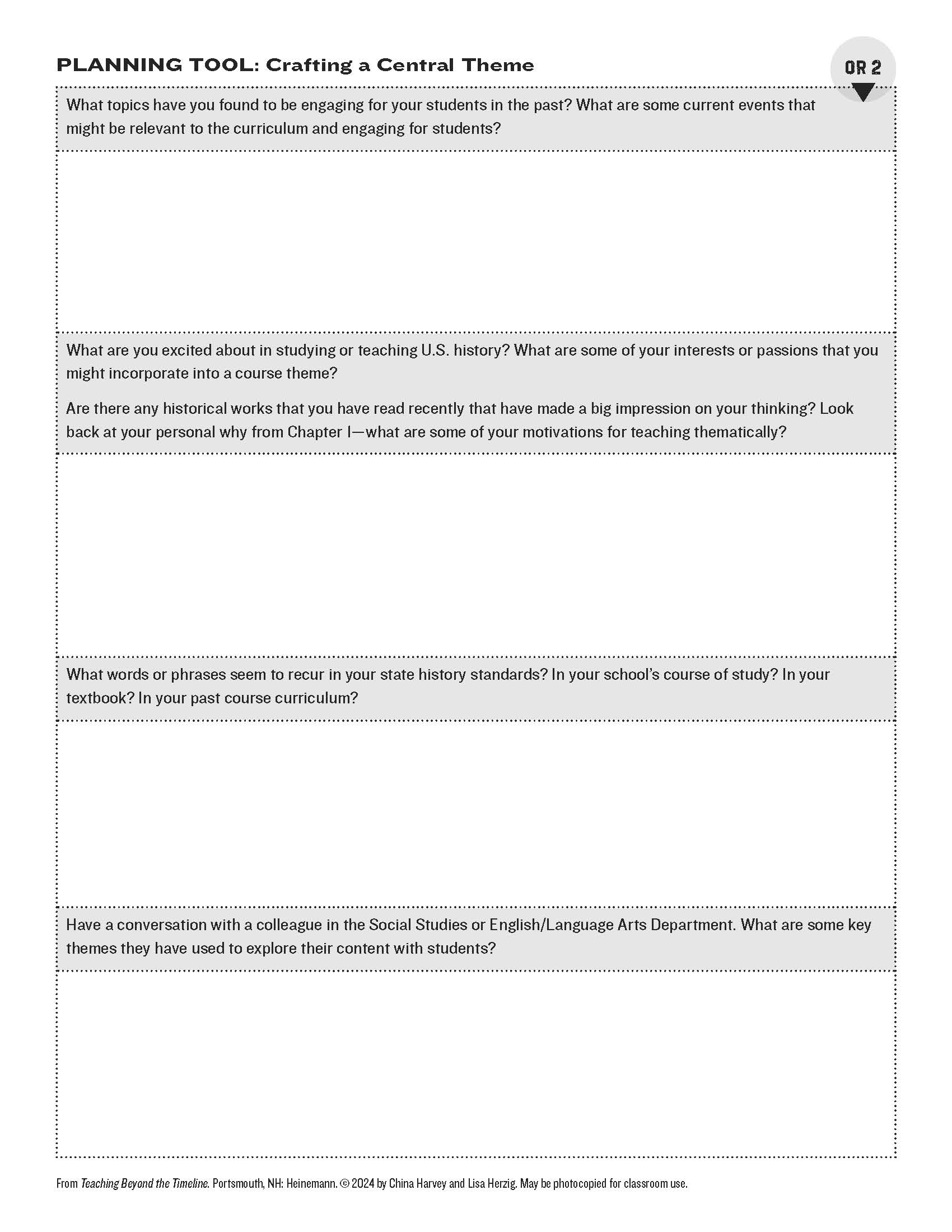
The following is an adapted excerpt from China Harvey and Lisa Herzig’s recently released Teaching Beyond the Timeline.
Vision is a necessary component of leadership and a valuable element in every classroom. Classrooms that do not have a clear vision often become inequitable, lack accountability, and fail to possess a sense of shared values or purpose. Creating a central, course-long theme for a thematic history course is important to embed vision to communicate course goals and provide transparency on how those goals will be met. The central theme also provides the basis of the historical narrative you want to impart to your students. A well-constructed and thoughtful theme can help anchor the course for students and for the teacher, providing a common thread through which the historical content will connect.

The central theme can be used throughout the school year in many ways. Your central theme will serve as a framework for each instructional unit. This will help you develop strong yearlong big-picture and unit-level focus questions. The central theme is also an invaluable guide for daily lesson planning. Truly, there is so much content to potentially cover that you really need to focus on the essentials; a well-designed course theme can assist in making the hard choices of what to emphasize and what to leave out. You cannot cover it all! A solid central theme can help you determine which resources, such as primary and secondary sources, videos, and textbook materials, to use within your lesson plans. The theme can be helpful in developing formative and summative assessments that reinforce course goals and objectives. The theme represents what it is you really want students to walk away with at the end of the school year.
Thematic Teaching in Action
When we chose our central theme, we considered our core values and reflected on what we wanted our students to get out of the course. We discussed our vision first. We believe students should see themselves reflected in the curriculum, and we want them to develop civic responsibility and see the value in being an active participant, all essential tenets of culturally responsive teaching. We also considered what was happening in the country at the time and thought about what would be most engaging and relevant to our students.
As we were developing our thematic course, the Black Lives Matter movement was growing in strength and momentum, rights of the LGBTQIA+ community were being debated in state houses across the country, women were losing their jobs in disproportionate numbers because of the COVID-19 pandemic, immigrant children from Central and South America were being detained at the U.S.–Mexico border. At the same time, higher minimum wages were being passed and more women and people of color were being elected to federal and state legislatures. All these topics that were piquing our students’ interests have deep roots in the history of the United States that were decades, or even centuries, in the making. Although they may be disparate topics, they all elicit questions of equality, liberty, freedom, and democracy, all fundamental principles of the United States. And they are all topics that are engaging and relevant to our students.

We knew we wanted present-day issues to be integral to our course, so we began brainstorming numerous central themes related to these topics. Looking at commonalities of each topic and how they each demonstrated both progress and regression for the groups involved, we initially chose “Struggle for Liberty and Equality” as our central theme. We wanted our students to explore the ways in which liberty and equality, two founding U.S. principles, have been fought for throughout history. However, we were dissatisfied with the word struggle. As lifelong learners of U.S. history ourselves, we were aware of the challenges Black Americans, women, immigrants, Native Americans, poor white Americans, and others have faced throughout the country’s history. But we were also aware of the strength, heart, determination, and resilience of these groups. We did not want to portray historically marginalized groups merely as victims, but as agents of change who agitated, advocated, and demanded the United States embody its founding ideals. So, after deliberating, we finally settled on “Striving for Liberty and Equality” as our central theme. This theme allowed us to create a course where our students would examine the extent to which the democratic ideals put forth in the Declaration of Independence and the U.S. Constitution, the United States’ founding documents, were accessible to all U.S. citizens. This theme could be traced across time and geographic location, through various demographic groups, up to the modern era. Our students could even apply this theme to themselves and reflect on the extent to which they have access to liberty and equality in the United States today.
The course theme should provide a common thread through which students can trace historical events up to the present day. It will serve as the framework for each of your instructional units, and ideally, be woven into each assessment. Do not rush the process of deciding on your central theme. Ultimately, reflect on what you think is engaging and relevant to your students. But we encourage you to develop a theme that allows aspects of various cultures and identities to be integrated into your course, as we find that allows students to see themselves in the history they are studying, making the historical content more meaningful for them. Once you have a theme on paper, wordsmith it, sleep on it, get feedback from a colleague, revise it if necessary after you brainstorm some unit themes . In the end, you want to be confident that you have chosen a theme that will guide you and your students through a yearlong exploration of U.S. history.

Teaching Beyond the Timeline: Engaging Students in Thematic History is a practical guide for shifting the the way we teach history in the middle and high school classroom. In order for our students to be truly engaged, we need to help them see the relevance of events in the past, moving from simple rote memorization to requiring students to meaningfully connect historical concepts, people, and events using patterns of comparison, causation, and elements of continuity and change over time. Courses organized around central themes also help to ensure inclusive and relevant curriculum for all our diverse students, a challenge that is difficult to overcome with a traditional, chronological approach.

China Harvey (L) is currently a high school social studies teacher and has served as instructional coach and teacher on special assignment, developing curriculum, leading professional development trainings, and helping to write the course of study for her district’s U.S. History course. She has led professional development workshops for teachers across the country, serving as a Teaching Fellow for Brown University’s The Choices Program, facilitating teacher cohorts for Learning for Justice, and working with elementary teachers and the community on moving beyond the myths surrounding Native American history.
Lisa Herzig (R) teaches high school students in World History, U.S. History, and AP U.S. History. Selected as a teacher on special assignment for her department, she was also a district finalist for “Teacher of the Year” award. Over the span of her career, she has helped create district-wide assessments, worked on curriculum development, and has written courses of study for World and U.S. History.
Related Reading

The following is an adapted excerpt from Teaching Beyond the Timeline by China Harvey and Lisa Herzig.

